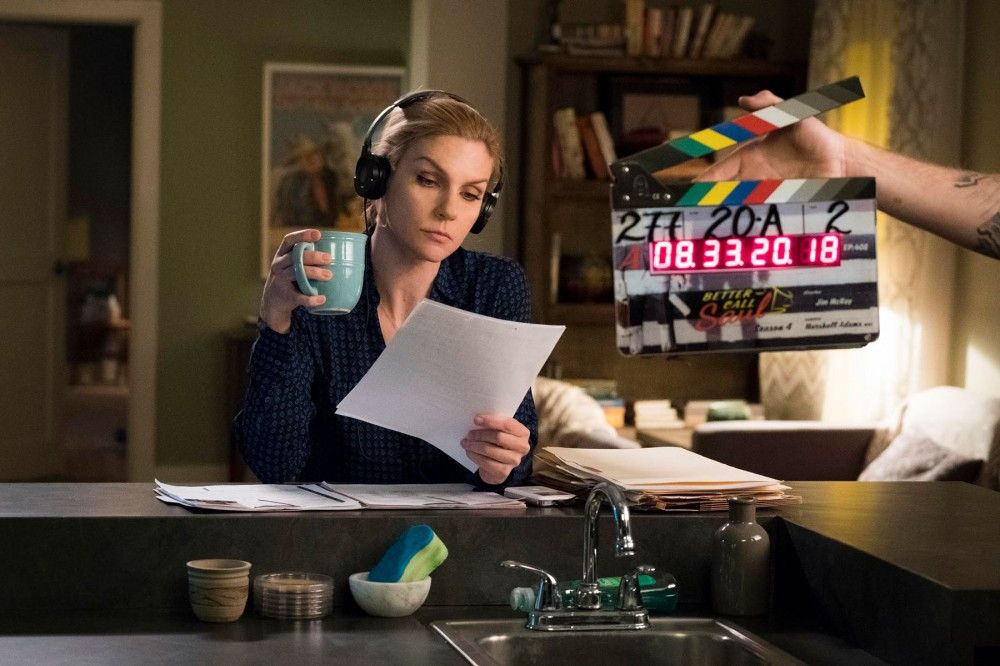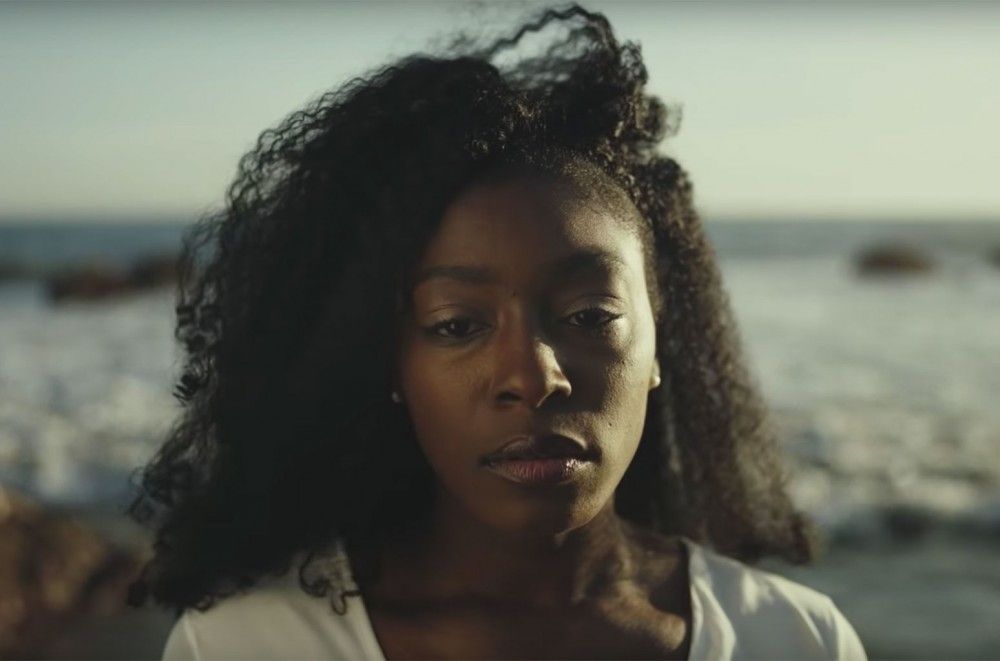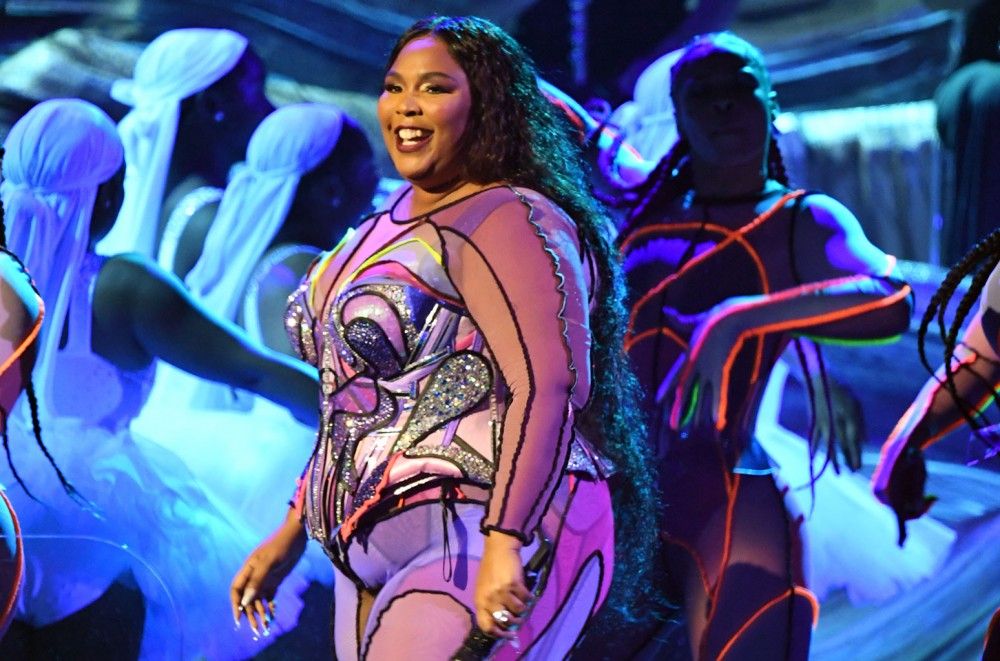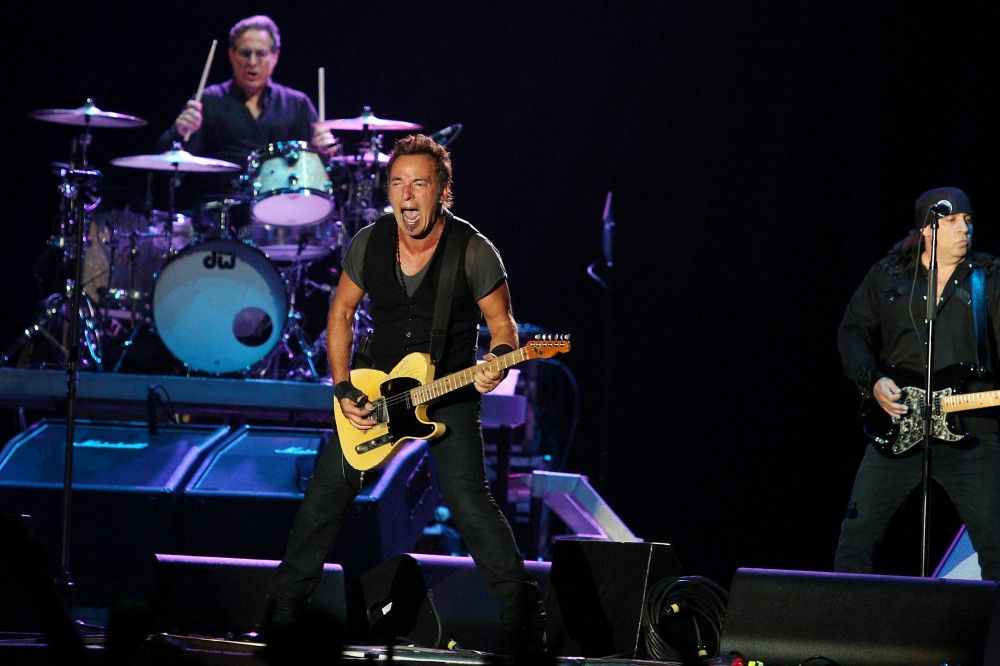
How Rhea Seehorn Became the MVP of 'Better Call Saul'
Rhea Seehorn really only came out to Hollywood so she could watch The Sopranos.
In the spring of 2003, Seehorn was nearly a decade into her acting career, largely in East Coast theater productions. The work was fulfilling, but low-paying. While all her friends had been raving for years about HBO’s epic mob drama, Seehorn hadn’t seen it; she couldn’t afford cable. So when her agent called her — while Seehorn was cleaning toilets for her day job as a receptionist at a Brooklyn construction site — to say she had gotten an audition for an ABC sitcom, her biggest concern was whether the studio would put her up in a hotel for the night.
“I thought, ‘It comes with a trip to L.A., and I finally get to watch The Sopranos? Let’s do it,’” she recalls now.
As it turned out, Seehorn didn’t get to see any of Tony and Carmela on that trip. The audition — for I’m With Her, a series loosely based on the relationship between the sitcom writer Chris Henchy and the actress Brooke Shields, where Seehorn would be reading for the actress character’s sister — was moved up to first thing in the morning after she arrived in town. She staggered into the studio still wearing the clothes she’d barely slept in, clueless about how to behave in this setting (she started eating a bagel before being told the food was meant for the executives), and did a five-minute riff as a character she had invented. She got the part, and moved to L.A. — and eventually got cable thanks to the bigger paycheck.
Seehorn has been working steadily ever since, in other sitcoms like Whitney, lighthearted dramas like The Starter Wife and Franklin & Bash, and now in her breakout role as Jimmy McGill’s conscience/girlfriend Kim Wexler on — among the very best of the complex cable dramas that The Sopranos made possible. Throughout, her career has been equal parts art and practicality, not just in the dirty jobs she had to take, like the one at the construction site, to make it happen, but in how she builds her characters out of rigorous study and questioning, finding intense power in extreme subtlety.
Seehorn’s work ethic is the reason Kim Wexler has evolved from a person for whom the show’s creators had no concrete plan, beyond giving Jimmy (Bob Odenkirk) a confidante, into the heart of the series, and the reason they drastically changed their original intentions about when and how Jimmy would become Saul Goodman. Kim has gone from afterthought to one of the most beloved characters on either Better Call Saul or Breaking Bad.
“She just brings so much depth, and there’s so much thought and so much intelligence to every moment that she plays,” says Saul co-creator Peter Gould. “She’s able to play all the ideas between the words and make them ring and sing. She’s just fascinating to watch. You want to know what’s going on between those ears.”

Seehorn in college
Born Deborah Rhea Seehorn, she began using her middle name — pronounced “Ray,” after the man who introduced her parents to one another — because “the Deborahs and Debbies that I knew or saw on TV always seemed to be really attractive cheerleaders, and it was not my lane at all in school,” Seehorn says. “I just remember feeling a disassociation with the name, from a very early age.”(*) Her mother was an executive assistant, mostly for the Navy, while her father was a counterintelligence agent for the Naval Investigative Service. His work led the family to move around a lot during Seehorn’s childhood, including stints in Japan, Arizona, and Virginia.
(*) Her sister is the only person to still call her Debbie “to bug the crap out of me, but that’s what sisters do.” Many fans mispronounce her name “RHEE-uh,” like Cheers star Rhea Perlman; Seehorn is too polite and happy to meet them to offer a correction.
“I never saw pictures, but you would hear stories,” she says of her father. “He was in Russia before the Iron Curtain came down, and apparently posed as] a woman at one point.”
There’s more than a bit of acting to that kind of work, though Seehorn and her dad never got to bond over the shared experience. He died when she was 18, at a time when she assumed she was going to be a painter. In college at George Mason University in Fairfax, Virginia, she was required to take an elective outside of her visual arts program, and tried an acting class.
“Thank god it wasn’t a feel-good, let’s just lie on the floor, feel how we feel about ourselves class,” she recalls. “It was all craft. It was practical aesthetics, handbook for actors — here’s how you break down a script, this is what an objective is, this is an obstacle. I was in such heaven that I never looked back after that.”
At the time, she was 45 pounds heavier than she is now, with a jet-black crew cut. She couldn’t imagine a world in which she would ever get to act on television, but thought the stage would be a good place for her. Her acting teacher, Lynnie Raybuck, encouraged her to check out the theater scene in nearby Washington, D.C., and soon Seehorn was offering to tackle any odd job that might get her noticed as someone who was both passionate and a hard worker.
“I volunteered to usher at Woolly Mammoth Theatre Company] for a year,” she says. “I volunteered for stage-running crew, box office, anything to make that bridge between academic and professional, so that I could learn professional things, be around professional people, show that I was willing to put in the hours. Also, when I got out for auditions, I’m not knocking on a door of someone who’s never seen me before. They’ve seen me making the disgusting fried eggs for a play that lasted all summer.”

A twentysomething Seehorn in a headshot from her D.C. theater days.
Eventually, she was getting significant theater roles (and rave reviews). She took odd jobs to pay the bills, like clerking at a record store or doing home repair using whatever knowledge she could glean by reading the how-to books at Home Depot. (“I learned how to re-caulk a bathtub after I had already told the guy that I could do it,” she says, admitting her work “was OK; it wasn’t great.”) A good source of income in those days was to appear in industrial films that corporations used to train their employees; in one, Seehorn played a woman calling into an AT&T hotline because the concept of voicemail confused her — “Like, I can’t understand how to hang up the phone; it’s insane.” (She’s heard from friends in the area that another — in which she teaches bartenders and waitresses how to deal with drunk customers — is still being used all these years later.)
She auditioned for what few film and TV productions were happening in the region: Her first TV role was in an episode of the Baltimore-based Homicide: Life on the Street. But even though her physical appearance had changed from her college days, that world still seemed at odds with how she saw herself.
“By then I was a 25-year-old blonde, so I would get sent in for the ingenue,” she says, “but I would go at it as a character actor. I can’t just play the guy’s girlfriend. If the most interesting thing about me is my boyfriend, I’m not going to get the part, because I would add all this subtext of like, ‘No, no, no. There has to be something going on with her. Was she abused? Why is she just standing there?’ I didn’t get parts for a while because of that.”
Seehorn had grown up idolizing Bea Arthur for playing brassy, no-bullshit women in sitcoms like Maude and Golden Girls. Starting with I’m With Her — where her character, Cheri Baldzikowski, was skeptical bordering on contemptuous of her sister’s new civilian boyfriend — she found herself playing younger versions of Bea Arthur parts in one sitcom after another. “I got typecast as something that I was very proud of,” she says, “which was this very wry, sarcastic, knowing woman].” Most of the shows were canceled quickly — NBC’s Whitney, at two seasons, was her longest pre-Saul gig — and some never aired at all(*), but the jobs kept coming, and Seehorn kept enjoying them.
(*) One of her failed pilots was Eva Adams, an adaptation of a popular international format where a womanizer is magically transformed into a woman. Because her character was supposed to really be Will Arnett, Seehorn was allowed to shadow the Arrested Development star for a few days to learn his mannerisms. “But every time Will knew I was watching him,” she says, “he’d sit super strange and walk really weird, totally to fuck with me.”
When you enter the business in a sitcom, though, the business sees you as a sitcom actor. Chances to audition for dramatic roles proved few and far between. One of the few casting directors willing to think outside the box with her was Sharon Bialy, who was intrigued by Seehorn’s theater resume, because, she says, “so many of the shows I do require an actor who can handle language well.” Bialy and her coworkers Sherry Thomas and Russell Scott frequently brought in Seehorn to read for more serious parts. Shortly before Better Call Saul went into pre-production, Seehorn lost out on two different jobs she badly wanted where Bialy was doing the casting. Bialy reached out with a message of encouragement.
“I just remember saying — and I’ve never said this to an actor before — ‘It didn’t work out, but there’s something coming up that I know will be the right job for you,’” Bialy says. “And I never say that, because you can never predict what will happen. But I had already read the pilot for Better Call Saul, and I just had an instinct that she would be great for the role. I said, ‘Just be patient. Hang in there.’”
There wasn’t much to Kim in that pilot, where she appears in only two scenes, with a handful of lines; Gould and Vince Gilligan hadn’t given the character much thought. As Gould puts it, “We knew there should be a woman in Jimmy’s life, somebody who was certainly as much a friend as anything else. That was about as much as we knew, that these two people had a history, and that it was a complicated history.” For the audition, to preserve secrecy on a high-profile project, they invented a couple of fake scenes: one about a cop who discovers her younger sister has left college (for which the cop is still giving her money) and become a crack-addicted prostitute; the other about a woman who has found success after leaving her small hometown, then runs into an old friend whom she may or may not have dated in the past. Seehorn impressed enough that Bialy told her then and there about the real character; after a confused, profane response (according to Bialy, she said, “Wait, she’s not a cop? She doesn’t have a sister? What the fuck?”), they kept going. “One of the important components is how quickly the actor can take the adjustment and shape it into something else,” says Bialy. “That’s what Rhea was able to do in the next take. It didn’t take her five takes; she got it immediately.”
Though many of the Saul writers had worked together on Breaking Bad, they struggled mightily to figure out what the spin-off should be in terms of story and tone, and how to use the characters who had never appeared on the parent show. Breaking Bad alum Gennifer Hutchison recalls a lot of early debate in the writers room over how Kim felt about Jimmy’s con-man side. In her script for the show’s fourth episode, “Hero,” Hutchison wrote a moment where Kim privately smiles in response to a Jimmy scheme that had outraged her boss, Howard Hamlin. (“Publicity stunt or not,” the stage directions read, “she liked it.”) With so little material early on, Seehorn had to invent a backstory and motivations in her head to make the character make sense to her, and over the years, many of those early ideas proved consistent with what the show gradually revealed about Kim. (This speaks to Seehorn’s instincts, but also to the writers watching what she was doing and following her lead.) Even before she got the “Hero” script, she had decided that it was more interesting if Kim was attracted to Jimmy in part because of his occasional criminal impulses rather than in spite of them. Director Colin Bucksey had her try a series of smiles — some big, some barely perceptible. “On a scale of one to 10, 10 being the biggest smile,” Seehorn says, “I think he picked one of my fours.”

Kim’s series-altering smile.
Though Gilligan and Gould weren’t sure at the script stage if the smile would stay, Seehorn’s performance unlocked the character — and, in many ways, the show — for them.
“The way she played it just felt so right that it gave us a strong feeling for where we were going with her,” says Gould.
The creators had assumed that Jimmy would become Saul fairly quickly, and ended that first season with Jimmy in the car after blowing off a job interview that Kim had arranged for him, a wicked grin on his face that Breaking Bad fans would recognize. It was only after the season was in the can that it occurred to Gould what a bad spot Jimmy was putting Kim in by ignoring this great opportunity she had arranged. (“We started saying, ‘Wait, did he just leave her high and dry?’” he explains.) The Season Two premiere revealed that Jimmy actually had gone to the meeting for her sake, and he would eventually take the job to impress her.
“That started changing the course of the story,” says Gould. “The emotional connection between these two characters had a gravitational pull that started twisting the whole story around. Right now, a lot of what happened on the show revolves around this very complicated — and I think very adult, in its own way — relationship between those two.”
That need for Jimmy, and for the show, to pay Kim the respect she’d earned by that point radically altered Saul in multiple ways. It slowed Jimmy’s transformation into the scoundrel Saul Goodman to a measured pace that more closely parallels the tragic moral descent of Saul’s most infamous client, Walter White. And it forced the creative team to essentially split the series in two, with Jimmy and Kim on one side and all the drug dealers on the other.
These changes remind Gilligan, only on a grander scale, of when he abandoned his initial plan on Breaking Bad to kill off Jesse Pinkman early in Season One. “Thank God, we got as lucky with Rhea as we did with Aaron Paul,” he says. “But this is different, because Jesse, God bless him, he and Walt were not really equals in their character dynamic. But these two characters are definitely equals, and most of the time, Kim is Jimmy’s better — certainly his better angel.”
That it was a silent, barely perceptible reaction that proved the Rosetta Stone for Kim, and for Better Call Saul, feels appropriate. Seehorn’s work throughout the series isn’t flashy. Kim is a control freak who keeps her emotions as tightly coiled as her signature power ponytail. Yet it’s clear throughout the show how she feels about Jimmy, about her co-workers, and about whatever mess she has found herself in(*). Seehorn trained herself to be a character actor at an age when no one envisioned her as such; those long-honed instincts to be understated and real are paying off fantastically in this role.
(*) Well, mostly clear. Because this is a show whose title character is a con man, and because Breaking Bad famously kept a few big plot twists secret from the audience, some Saul viewers are conditioned to mistrust some things Kim says and does, like a speech she gave earlier this season about her unhappy childhood, or the letter she gave Jimmy that was allegedly written by his late brother, Chuck. In both of those situations, Seehorn played Kim’s intentions as sincere (and the latest episode confirmed the childhood story as true), though she’s grown used to fans questioning them.
The only downside to such incredible but nuanced work is that Seehorn has yet to be recognized for it by her peers. Where Odenkirk, Jonathan Banks, Giancarlo Esposito, and Michael McKean have all received Emmy nominations for the show, Seehorn is 0-for-4 to date.
“I think she’s been robbed,” laments Sharon Bialy. “I think one of the reasons is her work is so seamless and honest and beautiful. It’s not showy. She just serves the writing. That kind of talent often goes unnoticed, because it’s so seamless. And I hope for the final seasons, people wake up.”
In the meantime, the rigorous training continues. Seehorn has never shared a scene with Banks, Esposito, or several of her other co-stars, yet she goes to the set to watch all of their scenes, even if she’s not working that day. For the moment, the cartel stories have nothing to do with what’s happening to Kim, yet she finds them very informative to what she has to play.
“It’s a very specific tone of show,” she explains. “For me, it sits just outside of realism and naturalism. There’s something kind of poetic about the way people shift in their speech or the way events unfold. I like that music in my ear as much as possible between my work. It’s not about me staying in character and walking around making people call me Kim; but completely removing myself from set and then going right into a scene the next morning is not as easy for me as it is for some actors. So, it’s selfish. And then I’m also just getting a free acting lesson. Jonathan and Giancarlo, when I watch their scenes, they teach me how to use the camera in a way that I didn’t come into this series understanding as much as I’m aspiring to now. Sometimes, when Kim has intimate moments, I used to turn away from the camera, because I do treat the camera as another person that’s there, and the audience is often my confidant in the scenes, because Kim can be very silent and withholding. And I’ll watch Jonathan and ask him questions. Or I’ll ask Giancarlo, ‘How do you invite the camera into the most private of moments without looking showy or without looking deliberate?’”

Seehorn with Odenkirk as Kim and Jimmy.
One of the more unsavory, and completely unintended, aspects of Breaking Bad was how a segment of that show’s audience turned viciously against Walt’s wife Skyler. On paper, she was the sympathetic figure in the story, but to some viewers, she was the nag who was trying to keep Walt from embracing his inner badass. Better Call Saul has even more explicitly positioned Kim as the woman who is keeping Jimmy from becoming Saul Goodman, yet it’s hard to find fans of the show who feel anything but adoration and protective feelings for her(*). Like a lot of things about the series, the change in response goes back to Kim’s secret smile, and to the feelings behind it. Kim enjoys Slippin’ Jimmy the grifter almost as much as the audience does, after all.
(*) Hard, but not impossible. Some viewers are only in it for the Breaking Bad-adjacent material, and Seehorn has occasionally heard secondhand from people who say that they can’t wait until Kim dies.
“She’s actually not telling him, ‘You should be what I want you to be,’” Seehorn argues of Kim. “She’s telling him, ‘That’s not what you said you wanted to be. I’m trying to help you be what you said you wanted to be.’ And then, secondly, as often as she’s warning him or slowing down his trajectory, she’s also the audience’s point of view about what’s charming and funny and loving and sweet about him.”
Kim is crucial to the series in another way. The fates of most of the cartel characters are already locked in, and if we don’t know exactly how Jimmy’s post-Breaking Bad exile as Omaha shopping mall Cinnabon manager Gene will end, most of his story has also already been written. That leaves Kim’s future as the great mystery of Better Call Saul. Does she die? Does Jimmy ruin her career? In the most recent episode (spoiler), Kim proposed marriage as a last-ditch effort to save their flagging relationship; is there a chance that when Saul Goodman went home from helping Walt and Jesse launder their money, Kim was there waiting for him? Or, for that matter, could Nebraska native Kim wander into Gene’s Cinnabon to give these star-crossed lovers an improbable happily-ever-after?
“What’s going to happen to Kim?” Gould wonders. “That’s maybe the biggest question we’ve got now. Kim and Nacho, but Kim is the one I’m worried about. I think there’s still a lot of hope for Kim Wexler.”
Seehorn binged all of Breaking Bad shortly after that show ended, and mostly doesn’t play fan-girl on the set. (Though when a scene in the fourth season took place in Saul Goodman’s famous office, she couldn’t resist posing for some photos of herself at his desk.) Early on, she spent a lot of time asking the same questions about Kim that we all have. The answers didn’t exist at that point — “We see about three inches down the road at any particular moment,” Gould admits — and she ultimately realized that finding out would be counterproductive, since her performance would be influenced by things that Kim didn’t yet know.
While reminding me several times throughout our conversation that she can’t technically say whether Kim will still be a regular character for the sixth and final season, Seehorn says of the eventual end of her time on the series, “I’m sad. I can’t think that I’m not sad about it. It’s the best part I’ve ever played, and I will miss that experience, and I will miss all the people on it. But I’ve made my peace as far as however I’m going out — it’s going to be the smartest way she could have possibly gone out. I trust them with her.”
“It’s funny how the character grew on us, and the actress, God knows, grew on us,” Gilligan says. “We just love her to pieces. She’s adorable, she’s funny as hell, she’s a good person, and she’s smart as a whip. And she helps center the show for me. That’s saying a lot, because every main actor on this show could carry their own TV show, but Rhea, she’s something else. She’s really special.”
The praise is nice, but in many ways, Seehorn still feels like that jet-lagged young woman from 17 years ago, stumbling into an audition with sheet marks on her face and no idea where she was or what she was supposed to do.



